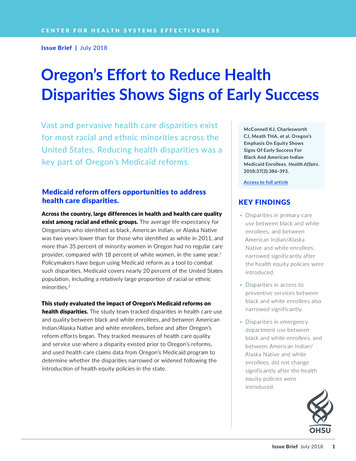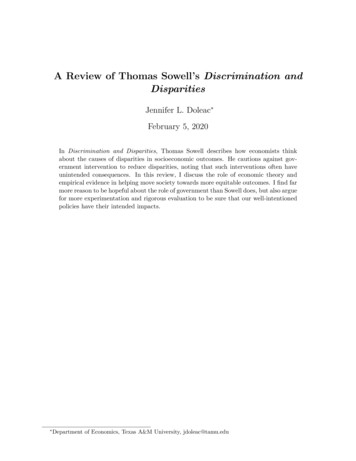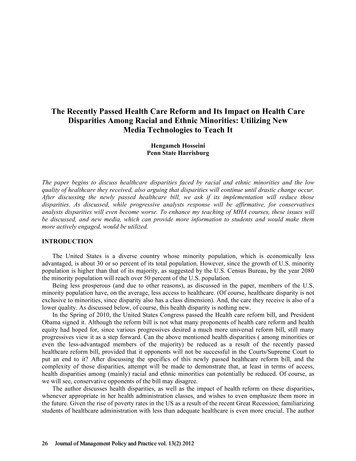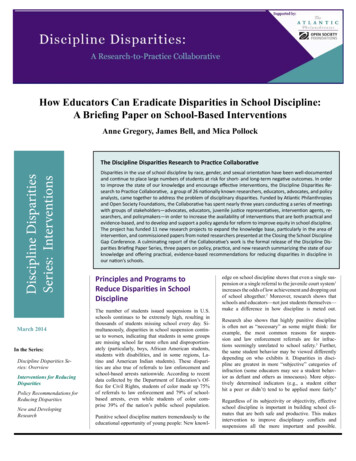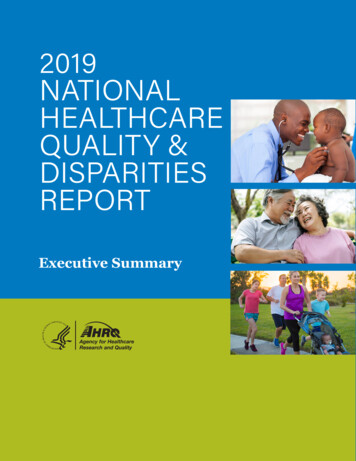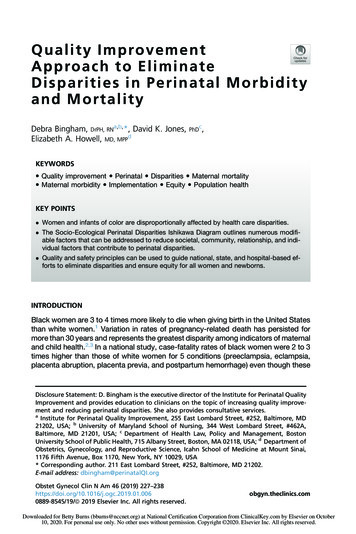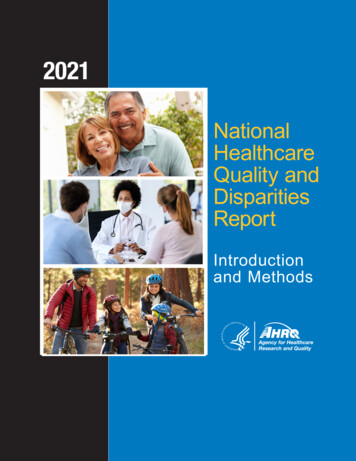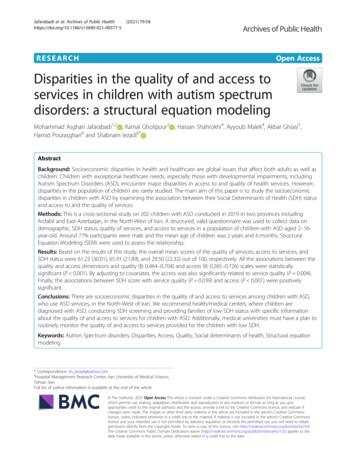
Transcription
Jafarabadi et al. Archives of Public Health(2021) EARCHOpen AccessDisparities in the quality of and access toservices in children with autism spectrumdisorders: a structural equation modelingMohammad Asghari Jafarabadi1,2 , Kamal Gholipour3 , Hassan Shahrokhi4, Ayyoub Malek4, Akbar Ghiasi5,Hamid Pourasghari6 and Shabnam Iezadi6*AbstractBackground: Socioeconomic disparities in health and healthcare are global issues that affect both adults as well aschildren. Children with exceptional healthcare needs, especially those with developmental impairments, includingAutism Spectrum Disorders (ASD), encounter major disparities in access to and quality of health services. However,disparities in the population of children are rarely studied. The main aim of this paper is to study the socioeconomicdisparities in children with ASD by examining the association between their Social Determinants of Health (SDH) statusand access to and the quality of services.Methods: This is a cross-sectional study on 202 children with ASD conducted in 2019 in two provinces includingArdabil and East-Azerbaijan, in the North-West of Iran. A structured, valid questionnaire was used to collect data ondemographic, SDH status, quality of services, and access to services in a population of children with ASD aged 2–16year-old. Around 77% participants were male and the mean age of children was 2 years and 6 months. StructuralEquation Modeling (SEM) were used to assess the relationship.Results: Based on the results of this study, the overall mean scores of the quality of services, access to services, andSDH status were 61.23 (30.01), 65.91 (21.89), and 29.50 (22.32) out of 100, respectively. All the associations between thequality and access dimensions and quality (B: 0.464–0.704) and access (B: 0.265–0.726) scales were statisticallysignificant (P 0.001). By adjusting to covariates, the access was also significantly related to service quality (P 0.004).Finally, the associations between SDH score with service quality (P 0.039) and access (P 0.001) were positivelysignificant.Conclusions: There are socioeconomic disparities in the quality of and access to services among children with ASD,who use ASD services, in the North-West of Iran. We recommend health/medical centers, where children arediagnosed with ASD, conducting SDH screening and providing families of low-SDH status with specific informationabout the quality of and access to services for children with ASD. Additionally, medical universities must have a plan toroutinely monitor the quality of and access to services provided for the children with low SDH.Keywords: Autism Spectrum disorders, Disparities, Access, Quality, Social determinants of health, Structural equationmodeling* Correspondence: sh iezadi@yahoo.com6Hospital Management Research Center, Iran University of Medical Science,Tehran, IranFull list of author information is available at the end of the article The Author(s). 2021 Open Access This article is licensed under a Creative Commons Attribution 4.0 International License,which permits use, sharing, adaptation, distribution and reproduction in any medium or format, as long as you giveappropriate credit to the original author(s) and the source, provide a link to the Creative Commons licence, and indicate ifchanges were made. The images or other third party material in this article are included in the article's Creative Commonslicence, unless indicated otherwise in a credit line to the material. If material is not included in the article's Creative Commonslicence and your intended use is not permitted by statutory regulation or exceeds the permitted use, you will need to obtainpermission directly from the copyright holder. To view a copy of this licence, visit http://creativecommons.org/licenses/by/4.0/.The Creative Commons Public Domain Dedication waiver ) applies to thedata made available in this article, unless otherwise stated in a credit line to the data.
Jafarabadi et al. Archives of Public Health(2021) 79:58BackgroundChildren with Autism Spectrum Disorders (ASD) experience lifelong neurodevelopmental impairments interferingwith their ability to social interactions and communication. Appropriate services and supports could improve thebehavioral and cognitive functioning of children with ASD[1], however, one specific service doesn’t fit all childrenwith ASD, and families often express interest in a broadarray of interventions when searching for best services fortheir child with ASD [2].According to evidence provided by the World HealthOrganization (WHO), individuals with ASD have higherrates of forgone health-care needs compared to the restof the population, and their access to services and supports is inadequate [3]. On the other hand, access tohealthcare for children with ASD can be affected byrace/ethnicity, education level, and the type of insurance[2]. Although there is no evidence to conclude that autismoccurrence depends on the families’ characteristics, suchas ethnicity, income, lifestyle, and education [4], somestudies on the association among sociodemographic characteristics, diagnosis, and health care services for childrenwith ASD have revealed socioeconomic and racial/ethnicdisparities [5–7].Access to evidence-based, high-quality services forchildren with ASD is a major public health issue [8]. Inthe previous decades, major efforts were made to improve children’s overall access to health care [9, 10].Nonetheless, disparities persist in access, utilization, andthe quality of care for certain subgroups of children, including those who are Black and Latino, live in lowerincome households, and have greater functional limitations [11]. Studies showed that in a population of children with exceptional healthcare needs, children withdevelopmental impairments, including autism, have encountered disparities in health services [12, 13], and, in apopulation of children with developmental impairmentsand other exceptional healthcare needs, children withASD face major challenges to achieve desired services[14, 15]. Lack of access to services and supports is animportant issue for people with autism, but in low- andmiddle-income countries (LMICs) there is a lack of dataon this problem [16].Another important issue in providing services for children with ASD is inequality in the quality of services.Quality of services is associated with patients’ satisfaction with care as well as ease of service use, both couldresult in better health outcomes [17]. Quality of healthcare is described as a measure of families’ perceptions oftheir children’s care and satisfaction with the health services provided according to acceptable cultural normsand values [11, 18]. Disparities in healthcare for childrenwith ASD not only exist in access to services but in thequality of healthcare as well. For example, a study byPage 2 of 11Montes and Halterman (2011) illustrated that families ofchildren with ASD had less chance to receive familycentered care compared to families without childrenwith ASD. Additionally, disparities were shown betweenblack and white families with children with ASD [18].Socioeconomic disparities in health and healthcare areglobal issues that affect both adults as well as children[8]. However, socioeconomic disparities in the population of children are rarely studied [8, 19], especially inLMICs. There is a large gap in evidence; most studiesexploring disparities in the quality of or access to healthcare in children with ASD are from developed countries,almost the Unite States (US) [19], and to our knowledge,there is no evidence from Iran to explore such disparities, neither in children with ASD nor those with otherlifelong disorders. This issue is particularly importantwhen taking a glance on statistics presented by WorldBank in 2017, which shows that more than 61% of allchildren in the world live in LMICs [20]. A systematicreview by Bishop-Fitzpatrick and Kind showed that moststudies on disparities have focused on race, and are particularly from the US [19]. Therefore, more researchesare needed from LMICs.In Iran, most special services needed by children withASD, particularly speech and occupation therapies andfamily training programs, are not delivered by public centers/clinics. Such services are delivered by independent,private organizations affiliated to welfare organizations.Furthermore, health insurance doesn’t have coverage forASD rehabilitation services [21]. These issues rise questions on the equity in the quality of and access to servicesfor children with ASD. Do all children with ASD and theirfamilies, irrespective of their socioeconomic status, haveequal access to services needed for their special conditions? Do they equally receive high-quality services? Toexplore disparities in the quality of and access to servicesprovided for children with ASD, we will examine the associations between these factors and children’s Social Determinants of Health (SDH).A conceptual model of SDH /Access/Quality of carewas developed to explain and predict the quality of careand access to service based on SDH status of childrenwith ASD [22–24] (Fig. 1), assuming two pathways: 1)predicting the quality of services by SDH pathway and 2)predicting access to services by the quality of servicespathway. SDH status of the caregivers explains the perceived quality of services by them. On the other hand,quality of services is a determinant of service utilizationand access to care.MethodDesign of the studyThis project is a part of Azeri Blue Buddies: Interdisciplinary Longitudinal Autism Researches (ABBILAR). This
Jafarabadi et al. Archives of Public Health(2021) 79:58Page 3 of 11Fig. 1 A conceptual model of association between social determinants of health and the quality of and access to services among children withautism spectrum disorders, North-West of Iran, 2019is a cross-sectional study conducted in two provinces,Ardabil and East-Azerbaijan, in the North-West of Iran.We examined associations among SDH status, access to,and the quality of services among children with ASD.Data were collected from July 1 to November 30, 2019,in all educational, treatment, and rehabilitation centers,where children with ASD receive their special servicessuch as rehabilitation and behavioral interventions.Sample size calculationThe minimum sample size was estimated 156 participants, given the number of observed variables (10) andlatent variables (3) in the model, the anticipated effectsize (0.05), and the desired probability (0.05) and statistical power levels (0.95) [25]. We recruited all eligibleparticipants, who were willing to take part in the study,and the sample size increased to 202.because of having any kind of disability or languageproblem and/or if they were not willing to participate inthe study. Prior to the data collection, we prepared a listof the number of children registered in each relevantcenter/clinic at both province levels. Therefore, whenthe interviewers went to the centers, they knew howmany participants they might have. Among the 219 caregivers of children with ASD, who were receiving services, in the two provinces, 17 refused to participate inthe study (three from Ardabil province and 14 fromEast-Azerbaijan province) and 202 individuals completedthe questionnaire (47 from Ardabil Province and 155from East-Azerbaijan province). A diagram showing thetypes of the participants recruited in the study is presented in Fig. 2.Participants and samplingMeasures and instrumentsSocial determinants of health (SDH)The target population was children with ASD and theirfamilies. Children aged 2–16-year-old with an ASD diagnosis document verified by a psychiatrist and who hadreceived at least one visit in the past six months wereeligible to participate in the study. We selected theformer criterion because centers/clinics provide servicesfor children with ASD aged 2–16-year-old, and, we selected the latter criterion because the participants weresupposed to evaluate the quality of and access to services, therefore, they needed to have a minimum level ofutilization of services. We used a history of a minimumof six months period to having contact with a center(and no longer) to avoid recall bias. The caregivers wereexcluded if they were not able to answer the questionsAfter making some modifications, an instrument extracted from Gottlieb et al.’s work was used to assess theSDH status of children with ASD [26]. The final questionnaire encompasses 18 individual items about theproblems in psychosocial areas, which explore howstressful are the main issues related to their income, jobsafety, insurance and access to healthcare, householding, and provision of staples. Likert-scale responseoptions were as follows: 6 “not at all stressful,” 5 “alittle bit stressful,” 4 “moderately stressful,” 3 “verystressful,” 2 “extremely stressful,” and 1 “issue listed isnot applicable to my family”. Total score was normalizedin a range from 0 (the lowest SDH) to 100 (the optimumSDH).
Jafarabadi et al. Archives of Public Health(2021) 79:58Page 4 of 11Fig. 2 Types of the participants recruited in the study to examine the disparities in the quality of and access to services among the children withautism spectrum disorders, North-West of Iran, 2019Quality of servicesWe considered four domains, including participation in decision making, care coordination, continuity of care, andtimeliness, to assess the quality of services; each domainconsisted of four questions. The questionnaire was derivedfrom the study of Sun et al. [27] with some modifications inthe content and number of questions through a panel ofprofessionals in the fields of health management and/orASD services. The questions were submitted with dichotomous answer categories (yes/no). The domain of participation in decision making included items in terms oflistening to caregivers and encouraging them to ask theirquestions, involving them in the care process, providingthem with adequate information on how to care of theirchild, and providing them with adequate information ontreatment choices. Domain of the care coordinationencompassed questions regarding the availability of a coordinator in the center, following-up the next visit,following-up the child’s referral to another center (if applicable), and routine contacts of the center with child’s school,daily-care center, etc. (if applicable). Domain of the continuity of care consisted of items about the receiving services from a specific therapist, receiving services from aspecific psychiatrist, adequate visit time, and the appropriate interval between visits. Domain of the timeliness included wasting time for language and occupationaltherapists and psychiatrist, the time interval between visits,and visit duration. Total score was normalized in a rangefrom 0 (the lowest quality) to 100 (the highest quality).Access to servicesWe used six domains to assess access to service based onprior researches in a similar field [23, 27]. Domains included problems in service use, problems in referrals, inadequate insurance coverage, cultural and family issues,problems in access to trusted providers, and problems related to waiting time. A dichotomous answer choice (yes/no) was considered as the response format for each question. Domain of the problems in service use included fiveitems: distance from medical/rehabilitation center, failureto make appointment, high cost, lack of awareness regarding the available services, and other explanations. Domainof the problems in referrals encompassed three items interms of the referral of the child to other centers (if applicable), including difficulty in the referral process, failure ofthe referrals, and not following up the referrals. Domain ofthe inadequate insurance coverage contained three itemsincluding, failure to receive a specific service or delay in getting that service, failure to receive specialty services, andusing services less than what parents felt needed. Domainof the cultural and family issues composed of three questions to explore if family and cultural issues had been a reason that a child had less utilization of services than needed,had left the center before receiving the service, or had notgone to the center for a long time. Domain of the problemsin access to trusted providers included four questionswhich explored if lack of trust in the psychiatry/providersof the service (two separate questions) and not having goodcommunication with them (two separate questions) hadmade them go to the center less than needed. The last domain, problems of waiting time, contained three items toexplore if a long waiting time had been a reason for lessutilization of services than needed, leaving the center beforereceiving the services, or changing the center. Total scorewas normalized in a range from 0 (the lowest access) to100 (the highest access).Other demographics and behavioral variablesThe background variables included age, gender, mothertongue, father and mother status (alive\divorced\died),
Jafarabadi et al. Archives of Public Health(2021) 79:58father and mother education level (illiterate\primaryschool\secondary school\high school\diploma\bachelor\master\doctorate or above), father and mother occupations, type of health insurance (Social Security\HealthService\Army\Iranian Health\Oil Company\Other (specify)\Uninsured), and sibling(s) with ASD (yes/no).Validity and reliability of the measuresThe measure illustrates a good to excellent ranges of internal consistency for the scales: SDH (α 0.924), qualityof services (α 0.704), and access to services (α 0.792).Questionnaires validity assessed and confirmed usingcontent validity. Construct validity of the measure wasassessed and confirmed using confirmatory factor analysis (CFA).Data collectionTwo pairs of trained interviewers collected data in eachprovince (four interviewers). After corresponding withthe University of Medical Sciences, the Education andTraining Organizations, and the Welfare Organization ineach province, and getting permission to collect datafrom related centers, a staff member (a secretary,teacher, or therapist) in each center invited parents ofchildren with ASD to participate in the study providingthem with brief information about the research teamand the objectives of the study and scheduled the interviews. Interviews lasted 40–50 min on average. After filling and signing the informed consent form, interviewersinterviewed with the participants in each center, wheretheir children received services, in a separate room to assure privacy, using a structured questionnaire. Interviewers didn’t interfere in the responses provided by theparticipants. They just explained the questions to theparticipants in case of any problem with any questions,regarding the illiterate participants. In the whole processof the interviews, a copy of the questions was providedto each participant and they selected their answers bytheir own unless they were illiterate. The role of the interviewers was just as a facilitator. At the end of eachinterview, the interviewers gave a gift worth 200,000 Rial(equal to 2) to each participant. Interviews were conducted in Turkish or Persian language based on the participants’ preferences.Page 5 of 11Missing at random (MAR) assumptions and imputationmethod was used to address missing data. Data were analyzed using the IBM SPSS Statistics, version 23 (IBMCorp., Armonk, N.Y., USA) and IBM SPSS Amos 24(IBM Corp., Armonk, N.Y., USA).ResultsAccording to the findings, a total of 202 caregivers ofchildren with ASD were recruited in the study, of whom152 were male (76.7%). The mean age of children was 2years and 6 months. The fathers of 10 children (5.1%)were dead and the parents of 7 children were divorced.In addition, 7 participants (3.5%) reported not having insurance coverage and 28 participants (14%) stated thatthey were covered by Iranian Health Insurance for free.(see Table 1).Based on the results of the current study, participationin decision making with a mean of 65.61 (36.07) scoredhighest among the quality dimensions. Also, the overallmean of the quality was 61.23 (30.01), indicating themoderate quality score of services provided to the children. Cultural and family domain got the highest score(84.44 out of 100) and the services use got the worstscore (49.73 out of 100) among the access dimensions.The mean of the SDH status of the children was 29.50out of 100 (see Table 2).Basic modelThe basic model fitted the data well after some modifications; χ2 (41) 78.330, P .001, χ2/df 1.91 5, TLI 0.86 0.8, CFI 0.9 0.8, RMSEA 0.07 .08 (90% CI (0.044 to 0.090). All the associations between the qualityand access dimensions and quality (B: 0.464–0.704) andaccess (B: 0.265–0.726) scales were statistically significant (P 0.001), as was assumed in the conceptualmodel. Access was also significantly related to servicequality (P 0.007). That is, the quality of services was amediator between SDH and access as well. Finally, inline with the conceptual model, the associations betweenSDH score with service quality (P 0.014) and access(P 0.001) were positively significant (Fig. 3), also,results are presented in the tabular format inadditional file 1.Model with covariateData analysisStructural equation modeling (SEM) was used to test thefitness of the measurement conceptual model. Goodnessof fit indices was used to investigate the fitness of themodel. Values smaller than 0.08 for root mean squareerror of approximation (RMSEA) and values greaterthan 0.90 for Tucker-Lewis index (TLI) and comparativefit index (CFI) confirmed the fitness of model (33). Pvalues 0.05 were considered statistically significant.The Model with covariate fitted the data well after somemodifications; χ2 (116) 202.76, P 0.001, χ2/df 1.81 5, TLI 0.83 0.8, CFI 0.9 0.8, RMSEA 0.06 .08(90% CI (0.049 to 0.077). In addition, all the associations between the quality and access dimensions, andquality and access scales were statistically significant(P 0.05). The access was also significantly related toservice quality (P 0.004). Finally, in the model with covariates, the associations between SDH Score with
Jafarabadi et al. Archives of Public Health(2021) 79:58Page 6 of 11Table 1 Demographic and background characteristics of thechildren with autism spectrum disorders participated in thestudy, North-West of Iran, 2019Table 2 Social determinants of health, quality, and accessscores reported by the caregivers of children with autismspectrum disorders, North-West of Iran, 2019VariableVariablesNoPercentChild GenderMean*SDQuality dimensionMale15276.7Participation in decision making65.6136.07Female4723.3Care 73.5Services usage49.7332.25126.0Referral60.1823.72Father statusFather EducationIlliterateContinuity of care60.8240.35Timeliness62.7238.24Total service quality61.2330.01Access dimensionHigh school10853.7Insurance coverage51.7140.86Academic8140.3Cultural and 1Manual worker6735.6Unemployed52.7Father JobAlive18996.5Divorce73.5126.5Mother EducationHigh school10852.2Academic8141.310753.5InsuranceSocial Security71.6932.58Waiting time77.7230.96Total65.9121.8929.5022.32SDHSDH Score* 0–100; 0 worst condition and 100 best conditionMother statusIlliterateAccess to trusted providerHealth Service2111.5Military84.5Iranian Health2814.0Oil Company2613.0Uninsured73.5service quality (P 0.039) and access (P 0.001) byadjusting to child age and gender, father and mothereducation, father job and diagnose to treat time werepositively significant. Finally, positive and significant associations were found between SDH Score and childage, and father education and job (P 0.05) (Fig. 4), also,results are presented in the tabular format inadditional file 2.DiscussionThis is the first study to explore the association betweenSDH, the quality of services, and access to services inchildren with ASD in Iran. According to the presentstudy, there is a positive association between SDH andthe quality of services and between SDH and access toservices in children with ASD. SDH status directly affected access to services and indirectly affected access toservices mediated by the quality of services.According to the results, the lower SDH status thechildren had the lower quality of services they experienced, which is consistent with the results of a previousstudy by Magaña in 2012 aimed to explore the racialand ethnic disparities in the quality of care in childrenwith ASD and other developmental disabilities [17].Magaña showed a significant gap in the quality of services between Black/Latino children and White childrenas well as between children with ASD and children withother developmental disabilities [17]. A recent study byZeleke et al. (2019) corroborates our results showingthat white children with ASD had more access to a larger variety of services and were more satisfied with theirhealthcare compared to minority groups [24].We also found out that children with lower SDH hadless access to healthcare and this association was mediated by the quality of services. In line to our results, several studies have highlighted significant disparities inaccess to and the quality of healthcare among childrenof racial/ethnic minority backgrounds with ASD or otherdevelopmental disabilities [17, 22, 28]. A growing rangeof evidence highlighted that Latino children diagnosedwith ASD have less access to and lower utilization andthe quality of healthcare in comparison to their whitepeers [15, 17, 29]. Durkin et al. (2015) showed a major
Jafarabadi et al. Archives of Public Health(2021) 79:58Page 7 of 11Fig. 3 Basic model of relationship between social determinants of health, the quality of and access to services, among children with autismspectrum disorders, North-West of Iran, 2019. Abbreviations: ASD, Autism Spectrum Disorder; SDH, Social Determinants of Health; SQ, ServiceQuality; ACC, Access; Q Participate, Participation Dimensions of the Quality; Q Coordination, Coordination Dimensions of the Quality;Q Continuous, Care Continuity Dimension of the Quality; Q Time, Timeliness Dimension of the Quality; Ac Referal, Referral Dimension of theAccess; Ac Insurance, Insurance Dimension of the Access; Ac Culture, Culture Dimension of the Access; Ac Provider, Provider Dimension of theAccess; Ac Time, Delayed Time Dimension of the Access; Ac Services, Service Availability Dimension of the Accessdisparity in access to a comprehensive variety of servicesfor children with ASD, especially in low-resources settings [30]. Since most services needed by children withASD for their specific condition is delivered by privateorganization affiliated to the Welfare Organization, it isnot surprising to see such inequality in access to servicesin Iran. Although the Welfare Organization provide asubside for the families to use those services, the eligibility criteria are not clear. It is really challenging for families, who have major difficulties in provision of theirbasic needs, to find and access high-quality, appropriate,and affordable services for their child with ASD. Thereis only one public autism center in the north-west ofIran. Nevertheless, health insurance does not have coverage for the services and the parents must pay most ofthe fees of their pocket.In our study, children with ASD experienced loweraccess to services in all domains including problems in access to services, problems in referrals, lack of insurancecoverage, cultural and family issues, problems in access toa trusted provider, and long waiting time. On the otherhand, quality of care was considered as a determinant toaccess to care. This is somewhat in line with the study ofVohra et al. (2014) in the US, which showed that childrenwith ASD had lower access to services than childrenwithout ASD, due to difficulties in using services, difficulties in getting referrals, and inadequate insurancecoverage. On the other hand, Vohra showed that childrenwith ASD experienced lower quality of services thanthose without ASD, in terms of lack of shared decisionmaking and lack of coordination [23]. In our study,although participants reported low access to services dueto inadequate insurance coverage, we didn’t adjust themain variables with the type of health insurance, because,in Iran, except Military and Oil Company insurance,other insurance do not have coverage for ASD services.In fact, there is no specific strategy in Iran to guaranteethe access of people with disabilities to healthcare services and adequate insurance coverage. Therefore, it isessential for policymakers in the health system to find asolution to guarantee the full coverage of these vulnerable groups [31]. Barriers to accessing the servicesneeded by children with ASD may have further negativeconsequences. The significance of the problem in accessto services is highlighted by Lindly et al. (2019), whichindicated the association between problems in access tohealthcare and greater emergency department use amongchildren with ASD [32].
Jafarabadi et al. Archives of Public Health(2021) 79:58Page 8 of 11Fig. 4 Full model of the associations between social determinants of health, the quality of and access to services among children with autismspectrum disorders by adjusting to covariates, North-West of Iran, 2019. Abbreviations: SDH, social determinants of health; ACC, access; Q, quality;Q Participate, Participation Dimensions of the Quality; Q Coordination, Coordination Dimensions of the Quality; Q Continuous, Care ContinuityDimension of the Quality; Q Time, Timeliness Dimension of the Quality; Ac Referal, Referral Dimension of the Access; Ac Insurance, InsuranceDimension of the Access; Ac Culture, Culture Dimension of the Access; Ac Provider, Provider Di
minants of Health (SDH). A conceptual model of SDH /Access/Quality of care was developed to explain and predict the quality of care and access to service based on SDH status of children with ASD [22-24] (Fig. 1), assuming two pathways: 1) predicting the quality of services by SDH pathway and 2) predicting access to services by the quality of .


